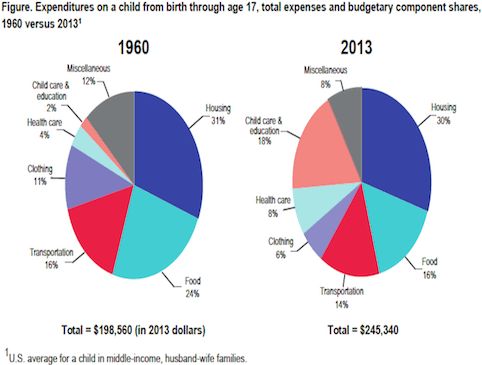The Cost of Raising & Educating Kids

The average cost of raising a child from birth through age 18 is about $250,000 (excluding the cost of birth, college, and lost wages in between) or $13,900 per year. That Department of Agriculture estimate includes an extra bedroom and some transportation cost which, for some families, may not be a marginal cost. But it is still breathtakingly high–about a quarter of annual median income of $54,000.
Bloomberg’s Megan McArdle remarks that the “last 50 years have seen a massive shift away from the basic expenses of keeping your kid alive and toward competitive expenses” including childcare and education. McArdle suggests we have “a collective-action problem that is steadily ratcheting up the amount we spend on our kids.”
Not surprisingly, affluent families spend twice as much as low income families. Spending of high-income families reaches $25,000 for teenagers compared to $15,000 in the middle range and around $10,000 at the bottom. That difference clearly feeds the opportunity gap–made more pronounced by more productive uses of technology in high income homes.
The study also makes clear that child rearing and housing are disproportionately high expenses for low income families–especially those in the urban Northeast.
Innovation consultant Dave Lash noted that the average child rearing expenditure is more than average school expenditure of about $12,600 per year. Lash noted that the combined parent and school cost is well over $26,000 per year to raise and educate children–about half the median income.
And we haven’t even considered the cost of college which, in some states has jumped by more than 70% over the last five year. State colleges are becoming increasingly selective and expensive–frequently topping $25k per year. To save more than $100,000 for college, a family would need to put away almost $6,000 per year–pushing average costs of child rearing to about $20,000 per year. Add the cost of K-12 education to that and you get $32,600 per year–about 60% of the median income.
Implications. While more than 90% of parents take advantage of free public education, they and other citizens pay for it through income and property tax (and, for college, lots of student loan debt). The grand total of $32,600 to raise a kid raises questions about economic sustainability. The disproportionality that falls on low income families raises questions about equity.
These cost pressures suggest that we need to develop better and cheaper learning options. The good news is that next generation learning models that are blended and competency based appear to be more productive. Instead of flat results and rising costs, the shift to next gen models could result in flat costs and rising academic results.
Breakthrough post secondary models and better career and technical education suggest the potential for more varied and affordable pathways to employment. Next month we’ll launch #GenDIY, a new series focused on young people creating their own pathways to employability.
In the long run, great learning opportunities are the key to economic development and civic participation. An opportunity platform with efficient pathways to family wage employment is the most important element in an equitable society.








0 Comments
Leave a Comment
Your email address will not be published. All fields are required.